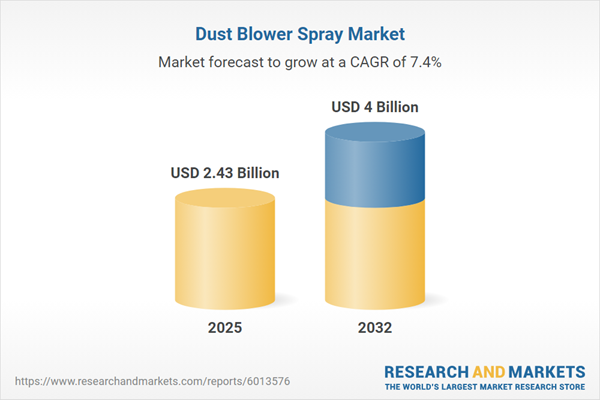Speak directly to the analyst to clarify any post sales queries you may have.
The dust blower spray market provides senior decision-makers with solutions designed to protect vital operational assets and maintain facility integrity across a range of industries. These products are engineered to address contamination control, operational reliability, and compliance challenges faced by enterprises worldwide.
Market Snapshot: Global Dust Blower Spray Market Trends
In 2024, the global dust blower spray market reached USD 2.26 billion, with a projected rise to USD 2.43 billion in 2025 and USD 4.00 billion by 2032. This progression reflects a CAGR of 7.36%, driven by growing adoption across automotive, electronics, medical, and industrial sectors where noncontact, precision cleaning is indispensable. The integration of advanced automation into operational workflows is resulting in upgrades to cleaning equipment, and evolving regulatory frameworks further motivate organizations to enhance their procurement approaches and compliance strategies. These market shifts emphasize continuous innovation and adaptation as companies align cleaning processes with business continuity and asset longevity goals.
Scope & Segmentation
- Product Types: Corded and cordless electric models, along with pneumatic dust blower sprays, enable tailored approaches across diverse facility environments, from precision workshops to manufacturing plants.
- End Uses: Automotive, electronics, household, industrial, and medical sectors form the core adopters. Electronics and medical environments emphasize stringent contamination control, while industrial and automotive segments focus on protecting sensitive machinery and reducing system downtime.
- Distribution Channels: Online marketplaces, retail stores, and wholesale networks serve enterprises with various purchasing needs—whether for rapid procurement, hands-on evaluation, or scaled supply and after-sales support.
- Operating Pressure Categories: High, medium, and low pressure variants cater to tasks ranging from delicate component cleaning to industrial-grade equipment maintenance, supporting organizations’ specific workflow requirements.
- Geographic Coverage: The Americas, Europe, Middle East and Africa, and Asia-Pacific regions make up the market landscape. The United States, Germany, China, and India drive notable advancements by integrating new technologies and adopting progressive regulations.
- Leading Companies: Falcon Safety Products, 3M Company, Fellowes Brands, XPOWER Electronics Cleaning, CRC Industries, MG Chemicals, Amazon, S.C. Johnson & Son, Hama GmbH, and Giottos Photography deliver product innovations to meet evolving cleaning benchmarks and diverse enterprise needs.
Key Takeaways for Senior Decision-Makers
- Effective contamination control strategies enhance system dependability in critical operations, minimizing unplanned downtime and supporting consistent output quality.
- Improved ergonomic and pressure-regulation features allow seamless integration with both digital and traditional maintenance operations, increasing efficiency and user safety.
- Environmental sustainability influences procurement, with growing organizational preference for models that optimize energy use and support corporate responsibility goals.
- Smart dust blower sprays equipped with IoT capabilities offer actionable analytics and predictive maintenance tools, enabling proactive risk mitigation and smarter management.
- Flexible procurement options allow enterprises to specify solutions that address unique operational challenges at both organizational and sectoral levels.
- Adaptable product portfolios and responsive supply chains help companies stay compliant with shifting regulations and maintain operational continuity in variable market conditions.
Tariff Impact: Strategic Response to United States Policy
With forthcoming changes in U.S. tariff policy in 2025, many companies are adopting regionalized or hybrid manufacturing and sourcing models. Emphasis on lightweight and modular dust blower spray components is increasing. These adjustments help enterprises navigate compliance and minimize disruptions as regulations and trade landscapes evolve.
Methodology & Data Sources
This report draws on executive interviews, expert insights, regulatory reviews, supplier data, and specialist trade publications. A comprehensive validation process ensures that findings provide senior leaders with reliable input for procurement, compliance, and strategic planning decisions.
Why This Report Matters
- Supports procurement and operations leaders in strengthening business continuity planning, enhancing regulatory compliance, and advancing digital transformation efforts across cleaning and maintenance functions.
- Clarifies the implications of new technologies and regulatory developments, enabling organizations to maintain long-term operational resilience in unpredictable environments.
- Promotes sustainable procurement and innovation, offering the flexibility required to adapt to evolving industry standards and customer requirements.
Conclusion
Senior leaders can utilize this report to refine procurement processes and operational strategies, building adaptability and resilience amid dynamic market demands and regulatory changes in the dust blower spray sector.
Additional Product Information:
- Purchase of this report includes 1 year online access with quarterly updates.
- This report can be updated on request. Please contact our Customer Experience team using the Ask a Question widget on our website.
Table of Contents
3. Executive Summary
4. Market Overview
7. Cumulative Impact of Artificial Intelligence 2025
Companies Mentioned
The companies profiled in this Dust Blower Spray market report include:- Falcon Safety Products, LLC
- 3M Company
- Fellowes Brands, LLC
- XPOWER Electronics Cleaning, LLC
- CRC Industries, Inc.
- MG Chemicals Ltd.
- Amazon.com, Inc.
- S. C. Johnson & Son, Inc.
- Hama GmbH & Co. KG
- Giottos Photography Co., Ltd.
Table Information
| Report Attribute | Details |
|---|---|
| No. of Pages | 199 |
| Published | November 2025 |
| Forecast Period | 2025 - 2032 |
| Estimated Market Value ( USD | $ 2.43 Billion |
| Forecasted Market Value ( USD | $ 4 Billion |
| Compound Annual Growth Rate | 7.3% |
| Regions Covered | Global |
| No. of Companies Mentioned | 11 |









